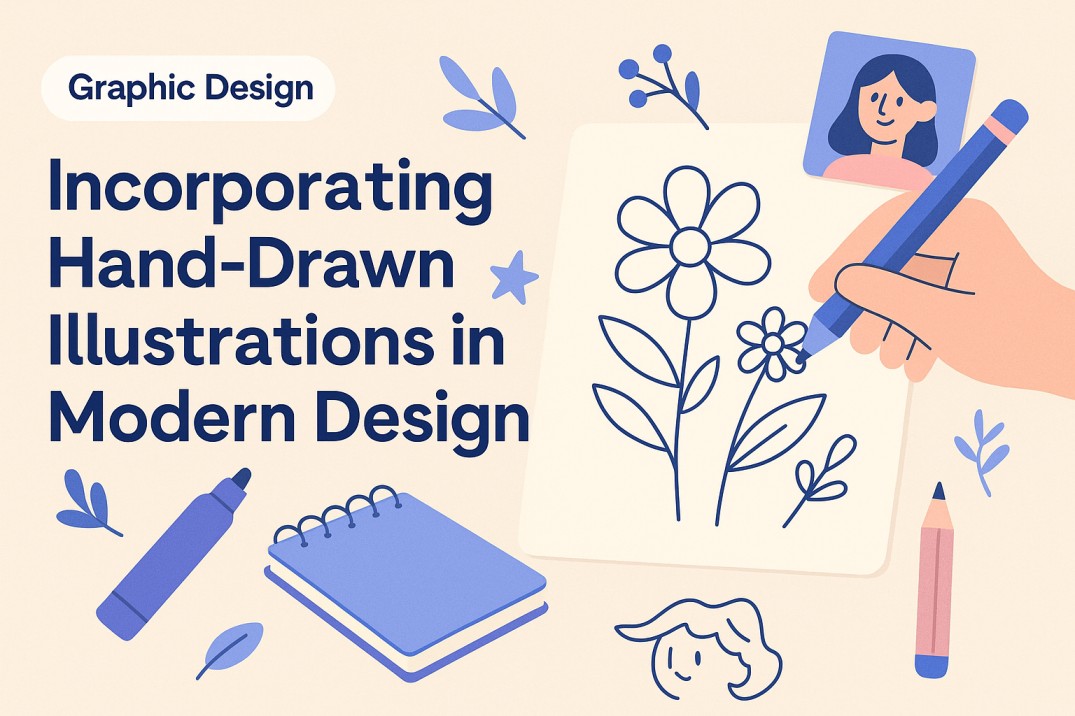To begin with, in a world dominated by sleek, polished digital graphics, there’s surprisingly a rebel: hand-drawn illustrations. For instance, these raw, imperfect, and uniquely human elements are now making a major comeback through hand-drawn illustrations modern design, thereby helping brands stand out in a sea of sameness. Moreover, from websites to packaging, hand-drawn illustrations in modern design are reintroducing personality, authenticity, and charm into visual storytelling.
As more brands aim to connect emotionally with their audiences, incorporating hand-drawn illustrations has become a strategic design move. Let’s explore how this trend works, why it’s effective, and how to incorporate it into your own design projects.
What Are Hand-Drawn Illustrations?
Hand-drawn illustrations are visuals created manually by an artist using traditional tools like pencils, pens, or brushes. Unlike vector graphics that are generated using software and are typically more geometric and scalable, hand-drawn illustrations are often imperfect, organic, and expressive.
Additionally, these drawings can be scanned, digitized, and further enhanced with digital tools—but their charm lies in the imperfections that come from the human touch.
Key Differences from Digital Vector Graphics:
- Texture & Line Variation: Hand-drawn lines vary naturally, unlike uniform digital strokes, thus adding depth.
- Emotional Warmth: Hand-drawn visuals feel more personal and emotional.
- Uniqueness: Every illustration is inherently original, giving brands a one-of-a-kind look.
Why Use Hand-Drawn Illustrations in Modern Design?
- Uniqueness & Brand Differentiation
- In an oversaturated digital market, custom hand-drawn art instantly sets your brand apart.
- Emotional Connection
- Human-made drawings evoke nostalgia and warmth. This emotional resonance can improve brand perception and loyalty.
- Authenticity
- Customers crave brands that feel real. Hand-drawn illustrations signal honesty and a human-centered approach.
- Versatility
- They work across mediums: digital platforms, physical packaging, merchandise, and more.
Real-World Use Cases and Examples
- Websites: Dropbox once used quirky hand-drawn doodles on its site to convey friendliness and approachability.
- Branding: Mailchimp’s playful brand identity includes hand-drawn elements that reinforce its casual, creative tone.
- Packaging: Small-batch food brands often use hand-drawn labels to create a rustic, homemade appeal.
- Social Media: Brands use hand-drawn stickers or doodles in Instagram stories to add personality.
Tips for Incorporating Hand-Drawn Elements into Your Design
- Start With Purpose
- Identify where a hand-drawn element can add value (e.g., illustrations for blog headers, icons, or hero banners).
- Keep it On-Brand
- Ensure that the illustration style aligns with your brand tone—whether it’s playful, minimal, elegant, or bold.
- Blend with Digital Elements
- Combine hand-drawn art with clean typography, structured layouts, or animations to strike a balance.
- Don’t Overuse
- Use hand-drawn features sparingly for emphasis. Too many can overwhelm your design or look unpolished.
Tools and Methods to Get Started
- Sketch & Scan
- Start with paper, sketch your designs, then scan them into your computer.
- Vectorize Using Adobe Illustrator
- Use the Image Trace feature to convert scanned drawings into scalable vectors.
- Digital Drawing Tools
- Use apps like Procreate, Adobe Fresco, or Photoshop to create hand-drawn art directly on a tablet.
- Combine & Enhance
- Layer illustrations with digital graphics, color them digitally, or animate them in After Effects for a hybrid look.
Balancing Handmade Aesthetics with Modern UI/UX
While hand-drawn art can be charming, it needs to be implemented thoughtfully to ensure usability and visual clarity:
- Use it for accents rather than primary navigation.
- Make sure legibility isn’t compromised.
- Combine illustrations with clear UI patterns and accessibility standards.
Overall, this balance ensures your design looks artistic without sacrificing functionality.
Best Practices for Combining Hand-Drawn Elements with Digital Design
- Firstly, pair expressive illustrations with clean, readable fonts.
- Secondly, use a limited color palette to unify hand-drawn and digital components.
- Then, maintain visual hierarchy by using illustrations to guide the viewer’s attention.
- Finally, test your designs across devices to ensure consistent appearance and performance.
The Art of Blending Tradition with Technology
Incorporating hand-drawn illustrations into modern design isn’t about going backward— instead, it’s about bringing back authenticity, creativity, and emotional resonance into a digital world. Moreover, when used thoughtfully, these artistic touches can breathe new life into your brand and help tell your story in a uniquely human way.
At Fuel IT Online, we believe that great design is equal parts art and strategy. So, if you’re ready to infuse your branding or marketing campaigns with personality through custom illustration and modern design, our creative team is here to help you bring your vision to life. So, Let’s craft something unforgettable together.




